当前位置:
X-MOL 学术
›
Surf. Interfaces
›
论文详情
Our official English website, www.x-mol.net, welcomes your feedback! (Note: you will need to create a separate account there.)
Adsorption behavior of heptafluorobutyronitrile decomposition components on the Cu(1 1 1) surface
Surfaces and Interfaces ( IF 5.7 ) Pub Date : 2024-07-04 , DOI: 10.1016/j.surfin.2024.104705 Changyun LI , Wendong WANG , Peigang CHEN
Surfaces and Interfaces ( IF 5.7 ) Pub Date : 2024-07-04 , DOI: 10.1016/j.surfin.2024.104705 Changyun LI , Wendong WANG , Peigang CHEN

|
The interaction mechanism of heptafluorobutyronitrile (CFN) decomposition components with Cu(1 1 1) surface under the external electric fields is investigated by DFT and MD. The results show that nitrile gases as well as COF molecules have smaller orbital energy gaps compared to perfluorinated gases, making it easy for the CFN decomposition component to lose electrons during the interaction with the Cu(1 1 1) surface. The interaction energy of CFCN and CFCN in nitrile gas with Cu(1 1 1) surface is weakened under external electric fields, while the two CN groups of CN make it almost unaffected compared to CFCN and CFCN. The MD study shows that some gas molecules accumulate on the Cu(1 1 1) surface when negative electric field is applied, while no gas molecules are found to accumulate on the Cu(1 1 1) surface when positive electric field is applied. Furthermore, as the temperature increases, the accumulation of gas molecules occurs in both positive and negative electric fields, among which nitrile gas molecules are predominate, which is not conducive to the compatibility of the gas-solid interface. The conclusions can provide theoretical guidance for the operation and maintenance of insulation equipment.
中文翻译:

七氟丁腈分解组分在Cu(1 1 1)表面的吸附行为
采用DFT和MD研究了外电场作用下七氟丁腈(CFN)分解组分与Cu(1 1 1)表面的相互作用机制。结果表明,与全氟化气体相比,腈类气体以及COF分子具有更小的轨道能隙,使得CFN分解组分在与Cu(1 1 1)表面相互作用时很容易失去电子。丁腈气体中CFCN和CFCN与Cu(1 1 1)表面的相互作用能在外电场作用下减弱,而CN的两个CN基团使其与CFCN和CFCN相比几乎不受影响。 MD研究表明,当施加负电场时,有一些气体分子聚集在Cu(1 1 1)表面上,而当施加正电场时,没有发现气体分子聚集在Cu(1 1 1)表面上。此外,随着温度的升高,在正电场和负电场中都会发生气体分子的聚集,其中腈类气体分子占主导地位,不利于气固界面的相容性。研究结论可为绝缘设备的运行和维护提供理论指导。
更新日期:2024-07-04
中文翻译:

七氟丁腈分解组分在Cu(1 1 1)表面的吸附行为
采用DFT和MD研究了外电场作用下七氟丁腈(CFN)分解组分与Cu(1 1 1)表面的相互作用机制。结果表明,与全氟化气体相比,腈类气体以及COF分子具有更小的轨道能隙,使得CFN分解组分在与Cu(1 1 1)表面相互作用时很容易失去电子。丁腈气体中CFCN和CFCN与Cu(1 1 1)表面的相互作用能在外电场作用下减弱,而CN的两个CN基团使其与CFCN和CFCN相比几乎不受影响。 MD研究表明,当施加负电场时,有一些气体分子聚集在Cu(1 1 1)表面上,而当施加正电场时,没有发现气体分子聚集在Cu(1 1 1)表面上。此外,随着温度的升高,在正电场和负电场中都会发生气体分子的聚集,其中腈类气体分子占主导地位,不利于气固界面的相容性。研究结论可为绝缘设备的运行和维护提供理论指导。
















































 京公网安备 11010802027423号
京公网安备 11010802027423号